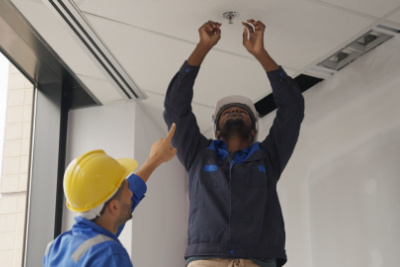Back to Basics is an article series that highlights important, but possibly overlooked, information facilities management professionals should know.

Whether facilities professionals are renovating an existing facility or doing new construction, installing the right type of sprinklers not only protects your facility from fires but also helps your organization adhere to federal, state, and local fire safety laws.
Why Install Fire Sprinklers?
Fire sprinklers can detect heat and provide water that should extinguish a fire. This will allow occupants to safely evacuate, allow firefighters safer access so they can extinguish the fire, and reduce fire damage. The National Institute for Occupational Safety and Health (NIOSH) notes that civilian fire death and injury rates are lower when fire sprinkler systems are present.
Which Commercial Facilities Need Sprinklers?
While local law can be more stringent, the National Fire Protection Association (NFPA) 13: Standard for the Installation of Sprinkler Systems 2022 edition states that the following commercial facilities are required to have sprinklers:
- New commercial structures of 5,000 square feet or larger
- Any remodels resulting in added square footage making the structure 5,000 square feet or larger
- Structures more than 55 feet tall
Types of Sprinkler Systems
According to “Sprinkler System Basics: Types of Sprinkler Systems” by NFPA Technical Services Engineer Valerie Ziavras, NFPA 13 allows for four sprinkler systems:
1. Wet Pipe Systems
Wet pipe systems, the most common type of sprinkler, have sprinkler piping that’s constantly filled with water, which flows out of the sprinkler head once the glass bulb or fusible link breaks when it meets a certain temperature, usually between 135° F and 170° F. Water will only flow out of the head when the temperature is met. This system is designed for facilities that are always 40° F or hotter so the water in the pipe doesn’t freeze.
Some facilities that have wet pipe systems include office buildings and retail stores.
2. Dry Pipe Systems
Facilities managers who have unconditioned spaces or locations where water could freeze should consider dry pipe systems, which don’t have pipes that are constantly filled with water. Instead, the water is held behind a dry pipe valve, usually away from where the sprinklers are located. When the glass bulb or fusible link breaks, the air is released from the now open sprinkler head, and the drop in pressure causes the dry pipe valve to open and water to fill the system, which results in water flowing from the open sprinkler head. The part of the building where the water comes in and the location of the dry pipe valve need to be hot enough to prevent freezing.
Facilities that usually have dry pipe systems include parking garages and unheated warehouses.
3. Preaction Systems
Preaction systems are the most complicated of all sprinkler systems, Ziavras notes, as there are distinct types based on whether the system is activated by heat detection devices and/or automatic sprinklers.
Heat detectors usually have a lower temperature rating than sprinklers, so the heat detection system is activated first.
These systems include:
- Non-interlock: Involves the operation of detection devices OR automatic sprinklers. Accidental damage to a sprinkler head resulting in the breaking of the glass bulb or the activation of the heat detectors would cause the system to fill with water, and the water would flow from the sprinkler. While some use this system for computer rooms, Ziavras doesn’t recommend this because it could create expensive water damage in a non-fire event.
- Single interlock: Involves the operation of detection devices. If the glass bulb is damaged, the system won’t fill with water, and the water won’t flow from the sprinkler. However, if the temperature activates the heat detection system, the system will fill with water, and water will flow from the sprinkler. This is beneficial in facilities where water damage, due to a damaged sprinkler head, is a concern. Ziavras recommends it for museums and computer rooms.
- Double interlock: Involves the operation of detection devices AND automatic sprinklers. The system will only fill with water after the activation of both the heat detection system and the operation of a sprinkler head. “If it is used in a museum or a similar type of environment, the delay in water delivery would allow the fire to continue to grow which could result in additional sprinklers opening. In turn, this could increase the water damage and result in a larger portion of the building being involved,” Ziavras writes, adding that this system was intended for facilities with freezer storage warehouses.
4. Deluge Systems
Deluge systems use open sprinklers or nozzles. Water won’t flow from the system until another type of detection system, such as a smoke detection system, is activated. Once activated, water will flow from every sprinkler head.
Ziavras reports that it’s ideal for high-hazard facilities such as aircraft hangars.
A Combination of Systems
Consider that your entire facility might benefit the most from using a combination of systems. Perhaps use a wet pipe system in warmer parts of the building and a dry pipe system in areas that aren’t conditioned.
Weighing Your Options
Weigh the pros and cons of wet pipe systems, dry pipe systems, preaction systems, and deluge systems, and consult with your local fire authority before installation. For more information, check out “What Happens When a Fire Sprinkler System Fails,” on Facilities Management Advisor.
